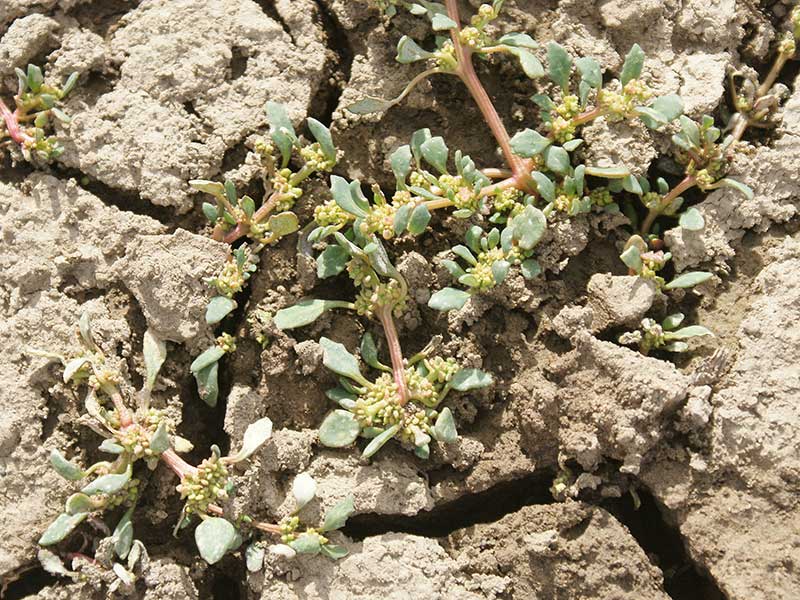Oxybasis glauca / oak-leaved goosefoot
- typically prostrate and small, apart from other plants
- mudflats and other drying wet areas
- small, blue-green, small-lobed leaves; often w/ reddish stems
- teeny clusters of teeny yellow flowers
- leaves feel cool and damp due to glandular hairs on lower surface
Also known as: oakleaf goosefoot, glaucous goosefoot
Synonym: Chenopodium glaucum
Oak-leaved goosefoot is an annual found mostly in moist/wet environments with disturbed soils such as gravel pits, empty lots, dumps, river banks, marly, sandy or gravelly shores, and the occasional garden. It loves nutrient rich conditions. The leaves are typically small, and the plants sprawling. If you go to the retreating shoreline of Palisades Reservoir, there are almost pure stands of this species on the mudflats, away from the competition, blooming well into October. If water returns, they will not appear next year, but the seeds will undoubtedly lie in the mud – and wait!
Although I prefer to start descriptions with the flowers, there really isn’t much to see here, and they are not the feature most useful for identification. Still, they are bisexual and capable of selfing. They bloom at the end of stems in small clusters (glomerules) less than 1/8 inch across. The overall form of the inflorescence is a short, dense spike. If you have a hand lens or a microscope, the flowers lack petals and have 1 to 3 short stamens and a green ovary with a 2-parted style at the tip.
There may be leaf-like bracts with some of the glomerules and these are visible (with a good imagination) in some of the gallery photos. An important feature is that the sepals and stalks are smooth and hairless while the bracts may be mealy white below.
Much more diagnostic are the leaves. They are alternate, and oblong/ovate. Their size varies with conditions, from ½ to 2 inches long. They have 2 to 4 shallow lobes or large teeth on each side – sort of resembling some kind of oak – with the lobes being either rounded or pointed, and protruding yellow-green midribs. The base tapers to the short petiole. The leaf surfaces are hairless and typically blue-green. The upper surface is smooth while the lower surface has white-mealy bits, aka a powdered look, due to glandular hairs. Interestingly, these give the leaves a cool feel even on hot days, similar to the feel of the more common lambs quarters.
The stems of oak-leaved goosefoot are also characteristic, often green to red or red-striped. They may also be mealy, especially on the upper stems.
Should you actually want to distinguish this from other Oxybasis spp., formerly Chenopdium spp… the leaves are typically small with a few shallow lobes. The flower/fruit clusters are not mealy. And within this species, there are two varieties. The introduced European one lacks the leaf-like bracts and has rounded lobes while the native species has the bracts and pointed teeth/lobes. I suppose they may interbreed because the photos in the gallery seem to have bracts, but rounded lobes.
| Color | |
|---|---|
| Family | |
| Blossom size | |
| Inflorescence size | |
| Inflorescence type | |
| When? | |
| Where? |


